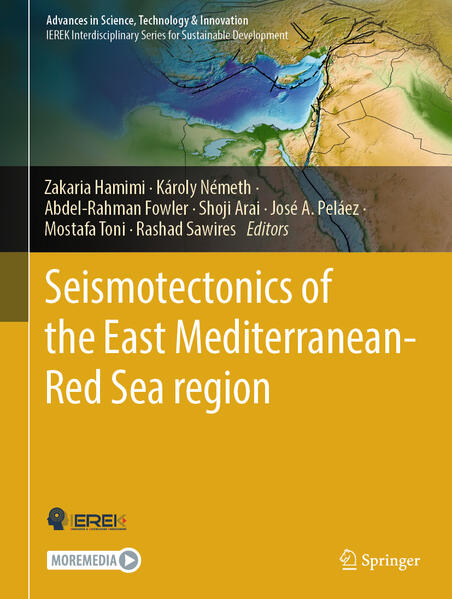
Zustellung: Mo, 28.07. - Do, 31.07.
Versand in 7 Tagen
VersandkostenfreiBestellen & in Filiale abholen:
This volume is considered as a unique book outlining new advances in seismotectonic research of the East Mediterranean-Red Sea Region (EMRSR). The dedicated chapters will outline the region in terms of tectonic segmentation, kinematics, and possible causes of it. It will provide state of art overview along-strike variations in geometry and behavior of faulting, jog characteristics of the active tectonic zones, analysis of earthquake clustering features, crustal deformation, constraining crustal velocity fields, relationship between strain rate and seismicity, paleoseismology, as well as global and regional seismicity. There will be specific topics within the book dedicated to the probabilistic seismic-hazard assessment of the EMRSR including its crustal stress field evolution and its implications for fault mechanics, earthquake source parameters and moment tensors, and description of double-coupled earthquake focal mechanism. Also, earthquake-induced deformational structures focusing on afterslip and spontaneous aseismic slip processes will provide a complete picture for the reader about this fascinating active region. Sections documenting the stress field variations and kinematics for diffuse microseismicity will also be developed. Other cutting edge research, such as progressive failure, spatiotemporal characteristics of seismicity that depends on accurate earthquake locations, as well as relationship of global distribution to earthquake-source geometry and tectonic origin provides up to date information within the EMRSR realm. The significance of the ambient noise level and site characterization specific to EMRSR and congruence and incongruence of active tectonic zones with normal plate kinematics will be shown in illustrative sections of this new book. The book also will explore the potential relationship of seismotectonics to sustainable development as a key societal aspect of seismotectonic research in an active convergent plate margin region such as the EMRSR.
Inhaltsverzeichnis
Introduction. - From the assembly of Pangaea to the closure of Tethys ocean: a synthesis. - Geologic and tectonic research in the East Mediterranean-Red Sea Region. - Evolution of the Afro-Arabian Rift System in space and time. - Interaction of the African, Arabian, Anatolian and Eurasian plates. - The conjugate East and North Anatolian Faults and the westward movement of Anatolian Block. - The Dead Sea Transform Fault System accommodating the left-lateral movement between the African and Arabian Plates. - The Gulf of Aqaba, the southern part of the Dead Sea Fault: geometrical and kinematic approach. - The Northern Red Sea-Gulf of Suez rift. - The rifted continental margin systems in the Gulf of Aden. - Paleoseismology in of the East Mediterranean-Red Sea Region: analysis of historical and instrumental earthquake catalogs. - Seismological aspects of the Mw 7. 8, 6th February 2023, Turkey/Syria earthquake and its aftershocks: Causes and consequences. - Seismotectonic frame of the East and North Anatolian Faults. - Crustal and uppermost mantle velocity structures in the Red Sea region. - Seismic tomography study beneath the East Mediterranean. - Seismicity of the Southern Red Sea and Gulf of Aden. - Relation of earthquakes to volcanic activity in the Arabian Peninsula. -
Ambient noise for seismic site characterization in the East Mediterranean-Red Sea Region: examples from some selected cities. - Path attenuation effect in selected countries of East Mediterranean and Red Sea Regions. - Source process and parameters for the major seismic events in the East Mediterranean-Red Sea Region. - Determination of site effects along the western Red Sea coast using microtremor measurements. - Magnitude estimation in the East Mediterranean-Red Sea Region s networks: description and performance of seismic networks. - Induced seismicity: causes and impact on the environment. - Moment Tensor Inversion for large magnitude earthquakes in the East Mediterranean zone. - Description and performanceof seismic networks in the East Mediterranean-Red Sea Region. - Analysis of seismicity and an up-to-date seismicity study of Northern Red Sea Rift and Sinai subplate using updated earthquake data. - Applications of the artificial intelligence and machine learning technologies for earthquake monitoring and analysis. - Seismic design and building codes in East Mediterranean/Red Sea countries. - Updating seismotectonic and hazard maps for the East Mediterranean-Red Sea Region. - Stochastic simulation of earthquake ground motions for selected events and locations in the East Mediterranean and Red Sea Regions. - Site-dependent seismic hazard assessment for selected active zones in the East Mediterranean and Red Sea Regions. - Seismic risk analysis for selected mega-projects in the East Mediterranean-Red Sea Region. - Determination of crustal movements using GPS and seismic data with emphasis on InSAR- and GNSS-Derived Seismic Hazard Models.
Produktdetails
Erscheinungsdatum
04. Juni 2025
Sprache
englisch
Seitenanzahl
712
Reihe
Advances in Science, Technology & Innovation
Herausgegeben von
Zakaria Hamimi, Károly Németh, Rashad Sawires, Shoji Arai, José A. Peláez, Mostafa Toni, Abdel-Rahman Fowler
Verlag/Hersteller
Produktart
gebunden
Abbildungen
XXII, 689 p. 487 illus., 443 illus. in color.
Gewicht
2165 g
Größe (L/B/H)
285/215/41 mm
ISBN
9783031809279
Entdecken Sie mehr
Bewertungen
0 Bewertungen
Es wurden noch keine Bewertungen abgegeben. Schreiben Sie die erste Bewertung zu "Seismotectonics of the East Mediterranean-Red Sea region" und helfen Sie damit anderen bei der Kaufentscheidung.









